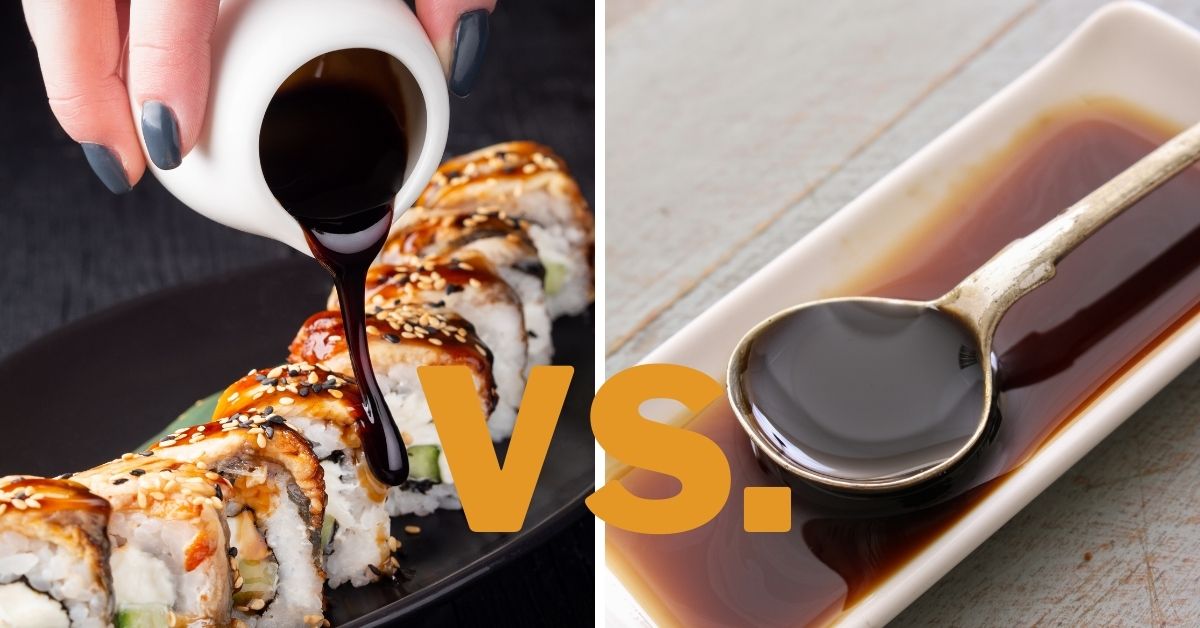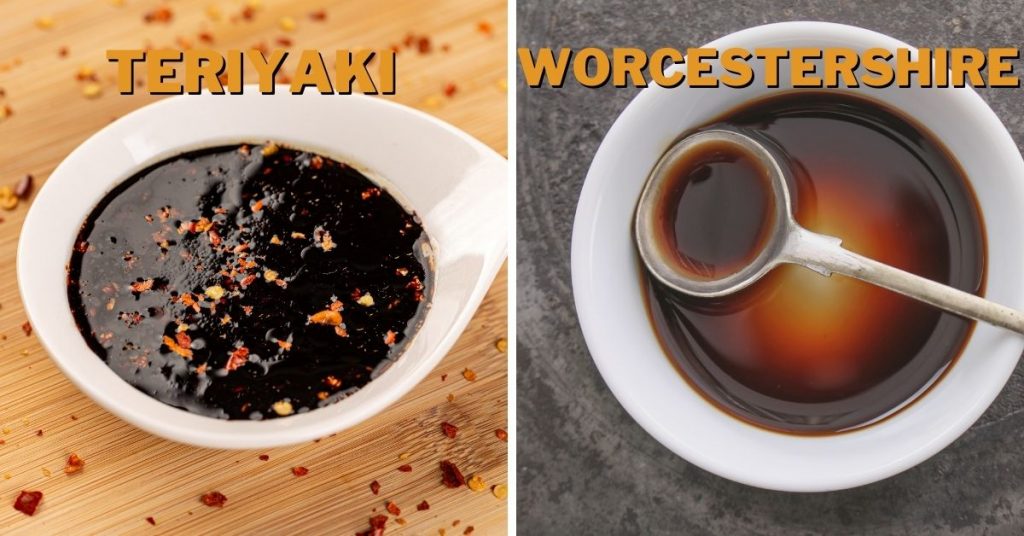Teriyaki vs. Worcestershire: Differences & Which One to Use?

Teriyaki and Worcestershire sauce share many similarities on the surface. This might make it confusing to choose between the two because do you know if they share any similar ingredients? So, what are the differences between Teriyaki and Worcestershire, and which one should you use?
Teriyaki is a Japanese condiment made from sugar, mirin, and soy sauce, while Worcestershire is a fermented vinegar-based sauce originating in the UK. Teriyaki sauce has a thicker consistency and fewer ingredients compared to Worcestershire sauce.
This article goes over the differences between these two common condiments in much deeper detail and explains their popularity and uses.
Teriyaki vs. Worcestershire: Differences
Origin
Teriyaki
Originating during the Tokugawa or Edo period in Japan, teriyaki is a dish that reflects the agricultural state of that time. The term “teriyaki” is composed of two Japanese words – “Teri” (which means luster or shine) and “Yaki” (which means grilled or broiled). This refers to the fact that teriyaki dishes often have a shine or luster.
And this shine is down to the main element of a teriyaki dish – the teriyaki sauce. So, people use this word to indicate both the specific sauce and the dishes made with it interchangeably.
Worcestershire
Worcestershire sauce is a condiment that became popular in the first half of the 19th century. The sauce originates from the city of Worcester, England. So, the name here derives from the place of origin rather than the quality of the product.
Two chemists, John Wheeley Lea and William Perrins, invented the original recipe for Worcestershire sauce, which they went on to sell under the brand name Lea & Perrins. But they do not own the trademark of this sauce, however. Many other brands have since made their versions of the Worcestershire sauce.
Ingredients
Different teriyaki dishes can drastically contrast each other. But the one thing that remains common in every one of these dishes is the sauce. The traditional teriyaki sauce is a simple mixture of 3 basic ingredients – sugar, mirin, and soy sauce. Mirin, for context, is a type of rice wine prominent in Japan.
Like teriyaki, Worcestershire sauce also uses a fermented ingredient as a base. But whereas teriyaki sauce utilizes fermented rice (mirin), Worcestershire incorporates fermented vinegar. This base is then augmented by ingredients such as tamarind, molasses, anchovies, onion, garlic, etc., and other seasoning and spices.
Flavors
The distinct flavors of a teriyaki dish derive from the sauce. It has a sweet yet tangy flavor that pairs very well with meat. The sweetness comes from the caramelized sugar. And the soy sauce adds a savory body. However, versions of the sauce replace the mirin with white wine, particularly in the US.
The flavors of Worcestershire sauce are unique. It is sweet yet savory, with a hint of tang. The fermented vinegar base provides this tang. Since Worcestershire sauce has many more ingredients to it than teriyaki, it has also seen a lot more variations. And depending on the ingredients used, the exact flavor of the sauce will vary.
Nutrition
Teriyaki sauce does feature plenty of sugar. This may not be ideal for people looking to cut down on their calorie intake. Also, the sodium level may not be appropriate for people with blood pressure problems. [1]
While Worcestershire sauce is not the healthiest option for a sauce, it’s not the most harmful. It’s low in carbs and fat-free. It has a high content of sodium. Just 1 tablespoon of this condiment can contain about 208 mg of sodium. [2]
Most of the adverse effects of Worcestershire sauce comes from a lot of its ingredients being common allergens. Since the sauce includes anchovies, it is not suitable for people with an allergy to fish. Similarly, many brands include gluten in their product which is also a common source of allergies for many people.
Use
Teriyaki sauce is primarily used as a glaze or a marinade. Typically, you will marinate fish and meat with the sauce before grilling or frying them. You can also add the sauce during the cooking process as with stir fry. Alternatively, you can drizzle the sauce at the end to give a glossy finish to a dish and add the flavors.
Just like teriyaki, you can also utilize Worcestershire sauce as a marinade. Or you can brush the sauce onto fish or meat that is grilling. The sauce can also go with stir-fried dishes and steamed vegetables.
Appearance
In keeping with the meaning behind its name, teriyaki dishes often have a certain sheen or luster. This is thanks to the caramelized sugar’s sparkling effect when you use the sauce as a marinade or garnish.
Worcestershire sauce has a smooth and silky consistency. The color of the sauce will vary according to the brand. But typically, it has a red to deep brown hue.

Popularity
Teriyaki-based dishes have been commonplace in Japan since the seventeenth century. After Japan came out of its isolationist period and its people slowly migrated to different parts of the world, their culture also grew in other parts of the world. As a result, teriyaki dishes became a staple in any place with a strong following for Japanese cuisine.
Currently, you can find teriyaki dishes in Japanese restaurants or dedicated teriyaki restaurants in many parts of the world. For example, there are at least 83 establishments in Seattle with the word “teriyaki” in their title.
Worcestershire sauce came into prominence during the 19th century. It slowly grew in popularity across the United Kingdom. Afterward, the sauce became widely distributed in various parts of the world, from Mexico and Costa Rica to Denmark and Germany.
Can You Substitute Teriyaki with Worcestershire?
You can use Worcestershire sauce in place of teriyaki in certain recipes. Worcestershire sauce has a lot of the sweet, tangy, umami flavor you come to associate with teriyaki sauce. So, you can use it as a substitute.
Can You Substitute Worcestershire with Teriyaki?
Teriyaki sauce can work in recipes that call for Worcestershire sauce. Teriyaki sauce will bring a combination of sweet and savory flavors. While teriyaki can be thicker than Worcestershire, the flavors will be close enough that it will not make a huge difference.
Teriyaki Vs. Worcestershire: Which One to Use?
Teriyaki and Worcestershire sauce share a lot of similarities in terms of flavor, color, and application. But the ingredients that make up these condiments are not the same.
For example, Worcestershire contains anchovies, tamarind, vinegar, etc. This makes it go particularly well with seafood. But they also prevent people who follow a vegetarian or vegan diet from using this sauce.
In contrast, teriyaki sauce is vegan friendly and does not have as does not contain things such as gluten or tamarind. Teriyaki sauce is also a simpler condiment to make. So, you can easily replicate the sauce at home.
